Diabetes is among the most commonly encountered chronic diseases worldwide. To manage the condition, it has become increasingly popular for people with diabetes to use mobile applications to ensure better health outcomes. The demand for accurate diabetes tracking software has led to the development of a number of diabetes management apps.
mySugr is one such application, and it provides users with an easy-to-use platform for tracking Users can explore valuable insights about their diabetes and have better control over it.
It allows users to enter activities, medications, food intake, and other information related to their condition.
If you’re also planning to build a similar diabetes management application for your users, this article will help you with every aspect of the same covering the overall process, features, and cost. Before we jump into the app development process and cost, let’s look at some statistics.
Diabetes Statistics:
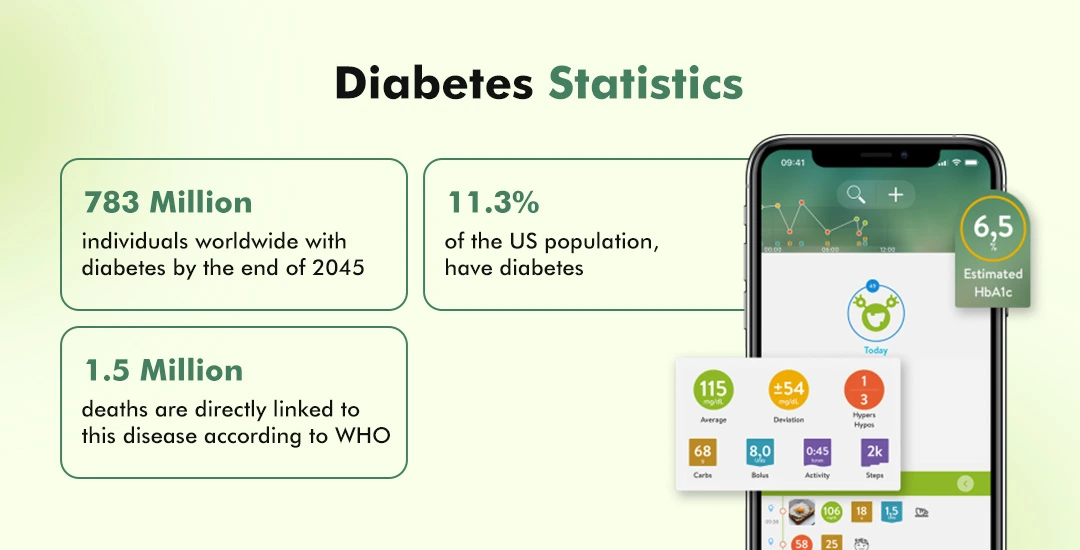
According to reports, in 2021, there were around 537 million individuals worldwide with diabetes. This number is projected to cross the mark of about 643 million by the end of 203 and approximately 783 million by 2045 end.
In America, around 37.3 million people, or 11.3% of the US population, have diabetes. In addition, 28.7 million people are diagnosed, and approximately 8.5 million individuals are undiagnosed as of now.
According to WHO, the majority of people having diabetes belong to low and middle-income countries, and around 1.5 million deaths are directly linked to this disease.
These statistics are horrifying, and it is essential to come up with solutions that will help manage diabetes more effectively. One such solution is developing a diabetes management app that will contribute to the overall healthcare industry. On this note, let’s look at why you should build an app like mySugr.
Why Build a Custom Diabetes Management App Like mySugr?
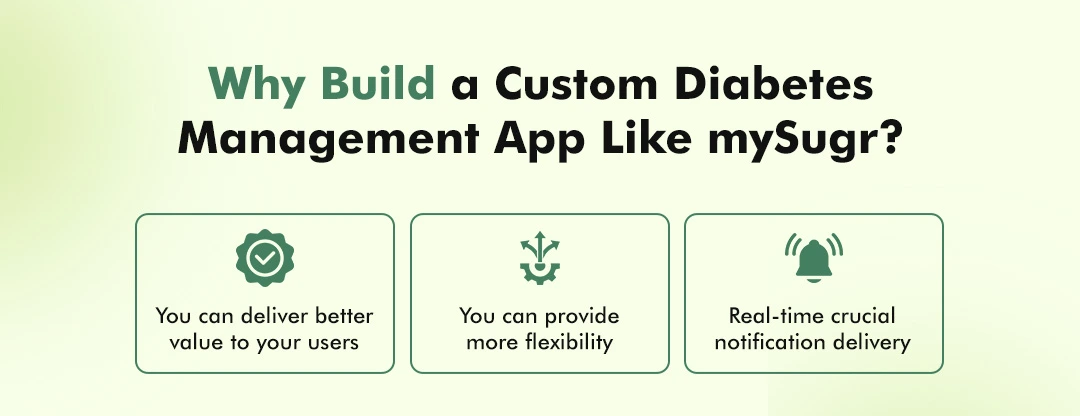
Building a bespoke diabetes tracker app like mySugr will bring you multiple benefits. Whether you’re an entrepreneur looking to launch a new product or an established medical company wanting to create the ultimate diabetes management solution, below are some reasons:
You Can Deliver Better Value To Your Users:
A custom diabetes management app like mySugr will be tailored to your user’s specific needs. It can be designed to provide more accurate insight into users’ glucose levels, enabling them to manage their diabetes better and improve health outcomes.
In addition, they can also be designed to provide personalized and actionable recommendations, helping users make informed decisions regarding treatment options. For example, you can offer tips and advice on nutrition, exercise, testing methods, and other lifestyle changes that can help users achieve their desired health goals.
You Can Provide More Flexibility:
When it comes to tracking and recording data, a custom app can enable users to customize their tracks. This way, they can select which kinds of information they want to track in order to better understand the effects of different treatments or lifestyle changes on their diabetes.
When users have the flexibility to customize the data they’re tracking, it allows them to make more informed decisions about their treatment plans. With a simple yet robust interface, users can easily record and store their data in individualized charts and graphs.

Real-time Crucial Notification Delivery:
By developing an app like mySugr mobile health app, people with diabetes can receive notifications that alert them to significant developments in their blood sugar levels. This allows users to take action quickly and appropriately, rather than having to check their numbers constantly and take action when they become too high or low.
In addition, by adding reminders for doctor’s appointments, medication, or dietary changes, users can proactively manage their diabetes without relying on anyone. These small yet effective solutions can have a big impact on diabetic management.
Now, let’s explore how to build a custom diabetes management app for your users so that they can take better control of their health.
How To Develop a Diabetes Management App Like mySugr?
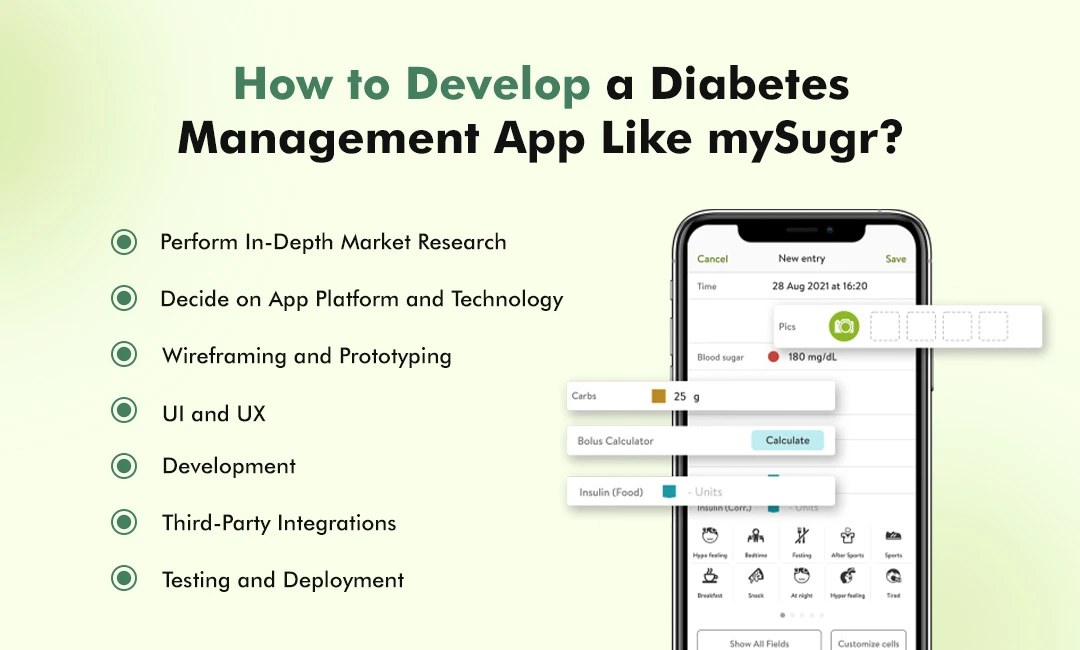
Before you get started with diabetes management app development, it’s important to understand the overall development process. Knowing different development stages and having a clear vision of your application is crucial for its success. Furthermore, you will understand the cost optimization metrics to develop an application.
Perform In-depth Market Research:
Before developing a diabetes management app, you need to analyze the market and competitors. Try to understand the current trends in this domain and build an application that can be easily adopted in the market. Analyzing user feedback and reviews will give you a better idea of the kind of features that you should include in your app.
Only building a similar app is never enough; you need some unique value proposition in your app. This will be the success factor for your application, so make sure you have something unique that differentiates it from other apps in the market.
Decide On App Platform And Technology:
The next step is to choose the platform and technology for your diabetes management app development. This will depend on factors like the budget, user base, features, scalability, and more. Once these are decided upon, it becomes easier to build an application that meets all requirements.
For example, if you want to build a native app for Android and iOS, you will need two separate development teams to build the app for each platform. If you are open to cross-platform development, then you can leverage powerful technologies like React Native, Flutter, or Xamarin.
Wireframing And Prototyping:
After you have identified all the features, it’s time to wireframe and prototype your app. This is an essential step in creating a successful diabetes management application. Wireframing helps you map out the user flows and define how the user interacts with different modules of your application.
With prototyping, you can quickly test how users will interact with your app and make necessary changes. This saves you a lot of development time by avoiding costly code rewrites later on. Developing an MVP will also help you gauge user response and feedback. Having an MVP will enable you to iterate and improve your app based on user feedback.
UI and UX:
When it comes to user-focused healthcare mobile application development, the overall interface should be intuitive and easy to use. This is where UI/UX design comes into play, and a good user interface should be designed with the target audience in mind. Your custom healthcare app designed with a beautiful and modern interface will make it easy to understand and navigate.
The app should also offer an interactive interface with features like reminders, notifications, and the ability to track data over a period of time. The navigation between different pages should also be seamless and help the user easily access all of the features.
Development:
For any custom healthcare app development, the programming language used will be an important factor for development. Swift and other iOS-specific languages are popular choices for developing iOS apps. An Android version of your app can also be created using native Java and Kotlin.
Ensure you opt for an agile development methodology, specifically Scrum, as it will give you the flexibility to scale up or down your project due to changes in scope. Additionally, a good user interface (UI) design is essential for creating an app that users will find intuitive and engaging.
Third-party Integrations:
While building your bespoke diabetes monitoring app, you need to figure out important third-party integrations like push notifications, data syncing, and analytics. You also need to consider integrations with other diabetes apps and devices to ensure seamless data-sharing.
Furthermore, you also have to consider regulatory compliance for medical-related apps. Ensure you are following all HIPAA and GDPR regulations with respect to data security and privacy.
Testing and Deployment:
Once the app is developed, you need to ensure that it works as intended. User testing and feedback from real users can give you valuable insights into how the app is performing.
You also need to consider how you will deliver the app to users, either through an app store or as a private distribution. If you choose an app store, you need to consider the approval process and other related requirements.
Now, let’s look at some of the must-have features that you can consider while building a diabetes management app like mySugr.
Must-have Features For Your Diabetes Management App
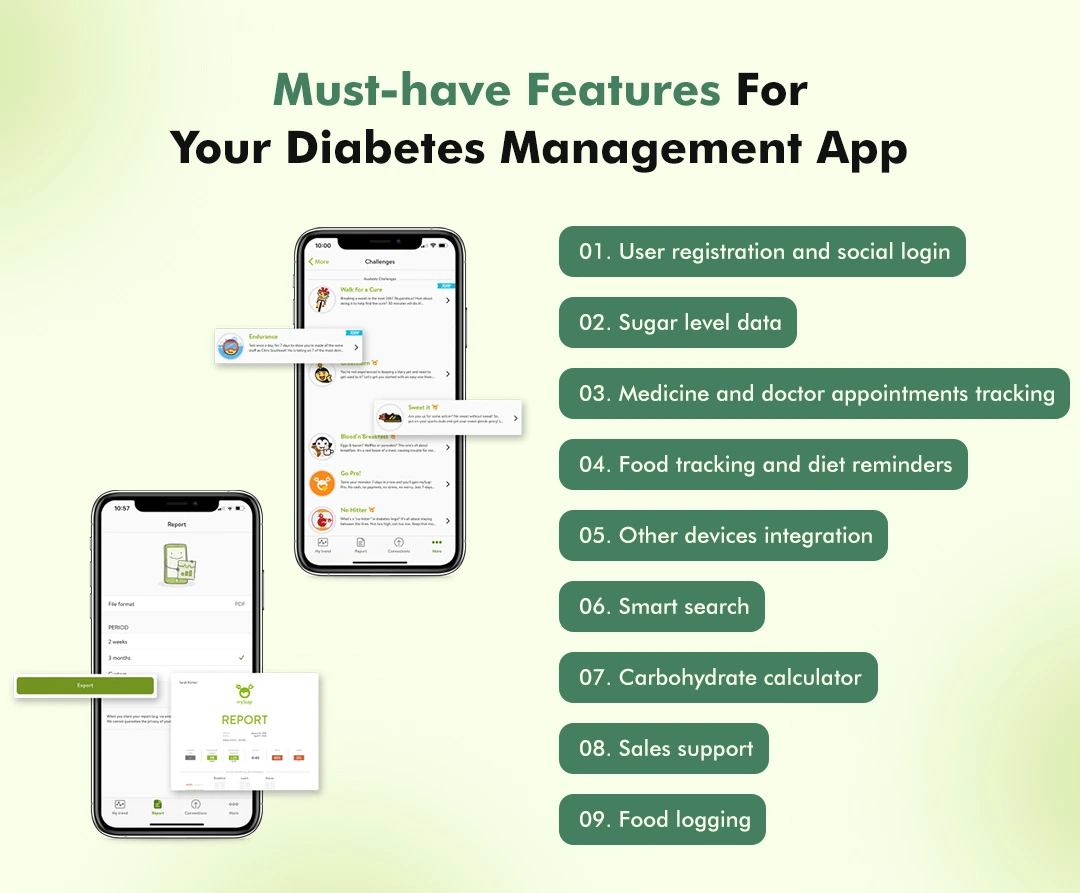
User Registration And Social Login:
The first step of user onboarding in your diabetes management app should be a quick and straightforward process. Offer users the option to sign up with their credentials or log in using a social media account.
Sugar Level Data:
Your diabetes management app should be able to track and store blood sugar levels. Data entry should be easy to understand, with a simple interface that allows users to select their type of diabetes and enter information about their fasting glucose or post-meal glucose levels.
Medicine And Doctor Appointments Tracking:
Users should be able to input and track their medications as well as schedule doctor’s appointments. Include a feature that allows users to set reminders for taking their medications. It’s a handy way for them to stay organized and ensure they are taking their medication as prescribed.
Food Tracking And Diet Reminders:
A custom diabetes management app should have the ability to track food intake and even recommend healthy meals to those suffering from diabetes. Further, a diet reminder feature can help users maintain their dietary goals and stay on track with their nutrition plans.
Other Devices Integration:
A custom diabetes management app should be able to integrate with other medical and fitness devices. This allows users to easily upload data from their glucose monitors and activity trackers, providing them with a comprehensive overview of their health.
Smart Search:
Include a search feature that allows users to quickly find relevant information. This could include food nutrition values, resources about diabetes management, and tips for living a healthy lifestyle. This can help users stay informed and help them manage their condition.
Carbohydrate Calculator:
A must-have feature for a custom diabetes management app is a carbohydrate calculator. This allows users to quickly and accurately count the total number of carbs in a given food item. This can be a great help to those managing their carbohydrate intake.
Sales Support:
It can be beneficial to include a sales support feature in your app. This allows users to contact the company with any questions or concerns they may have about the product. It also allows them to easily purchase additional items or services that are relevant to their condition.
Food Logging:
Your diabetes management app should also include a feature for food logging. This allows users to track the foods they eat and their portion sizes, allowing them to make informed decisions about their diet. Additionally, it can also provide insights into their food choices and help them identify any patterns that may be contributing to their diabetes.
After exploring the features, let’s explore how much you will need to pay to develop a bespoke diabetes monitoring application.
How Much Does It Cost To Build a Custom Diabetes App Like mySugr?
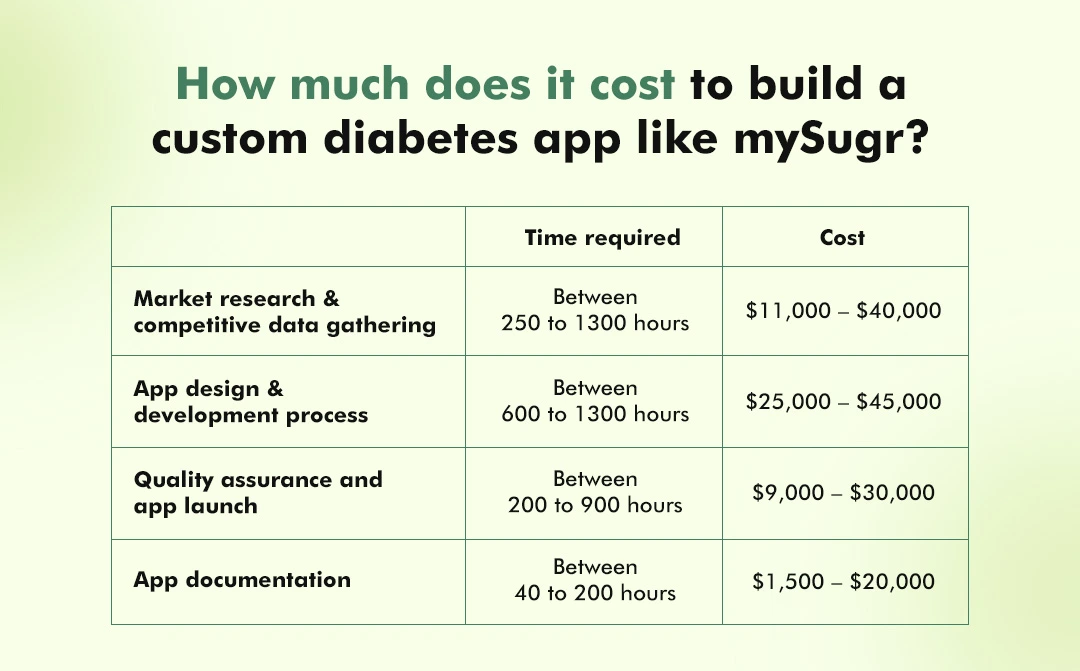
The cost of building a custom diabetes management app like mySugr will vary depending on the complexity of the application, the number of features, and the amount of time it will take to develop. Generally speaking, developing a custom diabetes app from scratch can cost anywhere between $25,000 to $75,000.
In the next section, let’s look at important factors that influence the overall cost so that you can effectively hire the best app developers to get the job done. Below is the approximate breakdown of the app development cost structure so that you can have a better understanding:
Market Research and Competitive Data Gathering
- Time Required: Between 250 to 1300 hours
- Cost: $11,000 – $40,000
App Design & Development Process
- Time Required: Between 600 to 1300 hours
- Cost: $25,000 – $45,000
Quality Assurance and App Launch
- Time Required: Between 200 to 900 hours
- Cost: $9,000 – $30,000
App Documentation
- Time Required: Between 40 to 200 hours
- Cost: $1,500 – $20,000
Factors Influencing The Cost of Developing a Custom Diabetes Monitoring App:
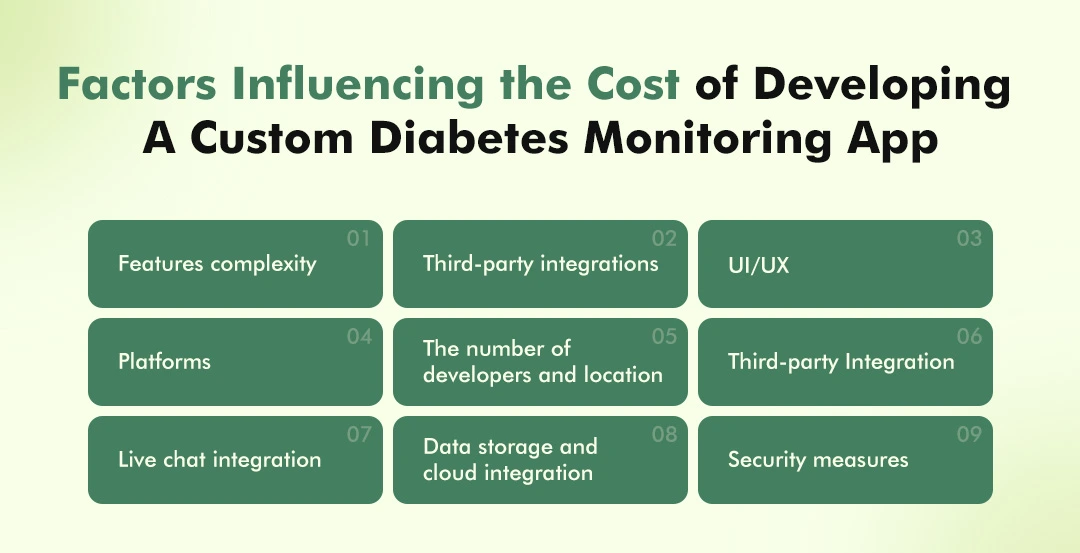
Features Complexity:
The features of a custom diabetes monitoring app can range from basic data tracking to complex health analysis. More intricate functionality will require more development time, which will affect the cost.
Third-party Integrations:
Integrating third-party services can increase the complexity of an app and lead to additional costs. These integrations include payment gateways, data storage services, push notifications, and more.
UI/UX:
Developing a good user experience (UX) for an app takes time and effort. The custom design of the user interface can also increase the cost of development. To stand apart from the rest of the competition, it is essential to provide a delightful experience for users.
Platforms:
The device platforms you decide to support will play an essential role in the cost of development. If you plan to support cross-platforms (iOS and Android), then the cost of development will rise. On the other hand, if you opt for cross-platform development tools such as React Native, then the cost of app development will be less.
The Number Of Developers And Location:
The number of developers required and their location will also have a significant impact on the cost. Opting for a professional offshore mobile app development company like AGS can reduce the cost of developing a custom diabetes monitoring app.
Third-party Integration:
Integrating third-party APIs such as glucose data and billing systems will also add to the cost of development. Popular APIs like OAuth2 and SMS gateways will further add to the overall cost. It’s crucial to figure out the kind of APIs needed for the diabetes monitoring app.
Live Chat Integration:
Live chat integration is another important factor that can affect the cost of creating a custom diabetes monitoring app. It may be necessary to integrate customer support services so that users can get quick help. This will require the development of a CRM system that is integrated into the app, or you can use a third-party solution, such as Zendesk or Freshdesk. The cost of live chat integration will depend on the features you choose.
Data Storage And Cloud Integration:
Data storage and cloud integration are also essential to consider. Depending on the type of data you need to store, it may be necessary to use a cloud service for storage. This will incur an additional cost, but you will benefit from the scalability and flexibility that it provides. Additionally, data stored in the cloud can be shared and accessed from anywhere in the world, making it easier for users to access their information.
Security Measures:
Security features like encryption, authentication, and two-factor authentication are essential for any diabetes monitoring app. It’s important to make sure that the data stored in the app is secure and can’t be accessed by anyone other than the user. Integrating security features will cost more, but it will be worth it in the long run.
After exploring the factors that will influence the overall development cost, let’s look at robust monetization strategies.
Monetization Strategies For a Diabetes Management App
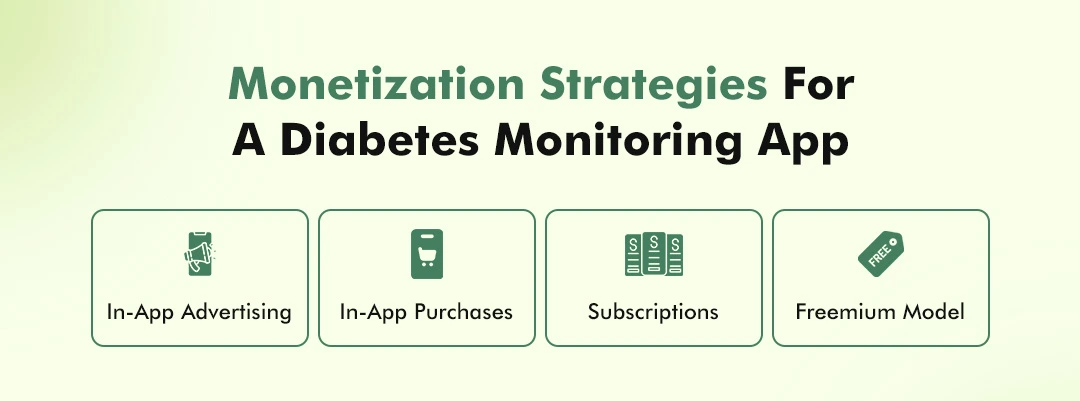
Monetization is a crucial part of any successful diabetes management app. While there are a variety of ways to generate revenue, it is essential to consider the most effective strategies for your particular app. Below are some of the most popular monetization strategies for diabetes management apps.
In-App Advertising:
One way to generate revenue for a diabetes management app is through in-app advertising. This involves displaying ads within the app that are targeted to users based on their interests and preferences. In return for displaying the ads, the app will earn a commission from the advertiser. This is a great way to monetize an app as it does not require users to pay anything directly but can still be an effective revenue generator.
In-App Purchases:
Another popular monetization strategy for diabetes management apps is in-app purchases. With in-app purchases, users can purchase digital content, such as additional features or new levels within the app. This allows developers to offer users an enhanced experience while also earning revenue from the sales.
Subscriptions:
Subscription services are becoming increasingly popular, and many diabetes management apps offer subscription services to their users. Subscriptions offer users access to additional features, content, or other benefits for a recurring fee. This is a great way to monetize an app, as it gives users the opportunity to purchase ongoing access to the service they love.
Freemium Model:
The freemium model is another popular monetization strategy for diabetes management apps. This model allows users to download the app and access most of its features for free, but they can also purchase additional features and benefits through in-app purchases. This setup gives users the flexibility to choose what they want and how much they’re willing to spend.
To ensure all the monetization strategies work seamlessly, you need to hire a professional app development company like AGS. By hiring an experienced team of developers, you can ensure that your app is designed with the latest features and technologies to maximize monetization potential.
Why Hire Auxano Global Services To Develop An App Like mySugr?
Auxano Global Services is a passionate healthcare app development company with a team of experienced professionals to create highly functional and effective diabetes management apps. From planning the app concept to creating the UI/UX design, our developers have the technical expertise to ensure a high-quality and cost-effective product.
We use industry-leading technologies such as React Native, Kotlin, and Node.js to build world-class apps for both iOS and Android platforms. Our development process also includes comprehensive testing of the app to ensure maximum user satisfaction.

With our agile approach to development, we move quickly from idea to finished product. We start with an initial consultation on client requirements and develop a custom-designed app that meets all your requirements.
With years of experience in creating healthcare applications, our team can create an app targeted specifically for diabetes management. Furthermore, we constantly update our tech stack to include the latest development tools and frameworks, such as React Native, Kotlin, and Node.js, that enhance user experience and functionality.
Wrapping Up!
Creating a diabetes management app like mySugr can be a complex process. But with the right team and state-of-the-art technologies, the process can be completed in a timely and cost-effective manner.
The exact cost of developing an app like mySugr depends on the complexity of design and features, as well as development time. On average, the cost of developing an app like mySugr ranges from $25,000 to $75,000. Additional costs may apply if you require additional features or customization.
Frequently Asked Questions
-
1. Why are diabetes management apps in demand?
Diabetes management apps are in demand because they provide a convenient way to monitor and manage diabetes. Such apps help users keep track of their blood sugar levels, dietary habits, and physical activity.
-
2. What features are included in a diabetes management app?
A diabetes management app typically includes features such as food and meal tracking, exercise tracking, medication reminders, glucose monitoring, and analytical insights.
-
3. What are the development costs of a diabetes management app?
The cost of developing an app like MySugr can vary depending on the features and complexity. Generally, the cost to build a diabetes management app would start from $25,000 and may go to $75,000 or higher.
-
4. Why should your company develop a diabetes management app?
A diabetes management app can be an effective way to help people manage their condition more effectively. You can add significant value to those struggling with diabetes, as well as their families and caretakers.
-
5. How long does it take to build a diabetes management app?
The development time for a diabetes management app would depend on the scope and complexity of the features. Generally, it would take about 6 to 12 months to develop a fully functional diabetes management app.



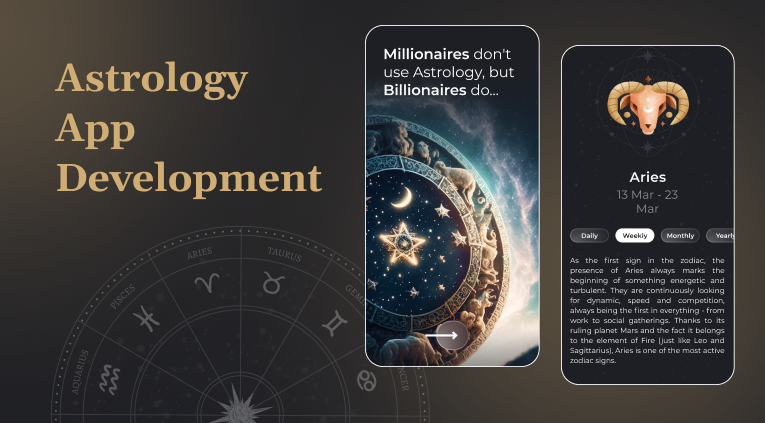

![Angular Vs. Rеact: What to Choose For Your Blockchain App? [2024]](https://www.auxanoglobalservices.com/agsresources/wp-content/uploads/2023/11/Front.png)
